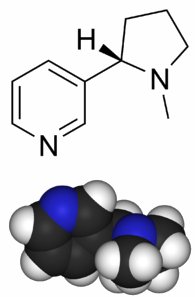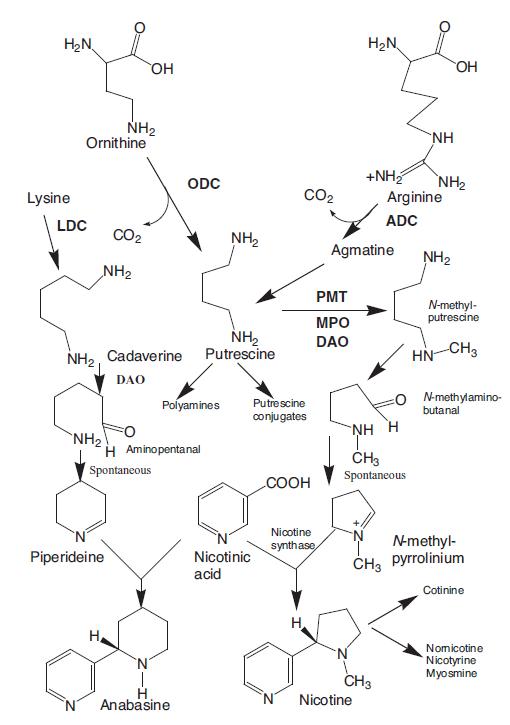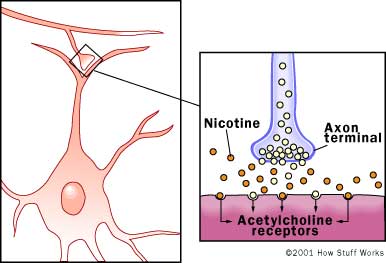| Hint | Food | 맛과향 | Diet | Health | 불량지식 | 자연과학 | My Book | 유튜브 | Frims | 원 료 | 제 품 | Update | Site |
|
독/약 ≫ 유형/기작/대응 ≫ 맹독성물질 담배 : Nicotine의 타감 작용  니코틴 : 담배 - 니코틴의 타감작용 - 니코틴의 약리작용 - 담배 : 중독성 - 중독성 물질 : 니코틴 카페인, 알콜 니코틴(nicotine)은 가지과의 식물에서 발견되는 염기성 물질로 주로 담배에서 많이 발견되며 토마토, 감자, 가지와 피망에도 적은양이 들어있다. 또한 코카나무의 잎에서 코카인과 같이 나오기도 한다. 대개 말린 담배잎의 0.6%에서 3.0%정도의 무게를 구성하는 물질로 담배의 뿌리에서 합성되어 잎에 축적된다. 니코틴은 곤충에 강력한 신경독성을 발휘하여 살충기능으로 작용한다. 그 때문에 과거에는 니코틴이 살충제로서 널리 사용되었다. 니코틴으로 남편 살해하고 재산 빼돌린 부인 구속 연합뉴스 | 입력 2016.08.21. 13:57 그동안 스스로 중독돼 사망한 사례는 있으나 니코틴 원액이 살인 범죄에 이용된 것은 국내에서 처음이다. 21일 경기 남양주경찰서 등에 따르면 지난 3월 A(54)씨가 남양주시내 자신의 집에서 숨진 채 발견됐다. 평소 매우 건강해 특별한 사인은 없었다. B씨는 남편이 숨진 뒤 단순 변사로 처리되는 줄 알고 집까지 처분하고 보험금도 수령했다. 그러나 경찰이 검찰 지휘를 받아 A씨 시신을 부검한 결과, 평소 담배를 피우지도 않은 A씨에게서 치사량의 니코틴이 검출됐다. 이에 경찰은 타살을 의심해 수사에 착수, A씨가 숨지기 두 달 전 뒤늦게 B씨와 혼인신고한 사실을 확인했다. A씨는 초혼으로, B씨와 같이 산 지 얼마되지 않은 사실도 파악했다. 경찰은 또 숨진 A씨의 계좌에서 돈이 빠져나가 B씨와 내연관계인 C씨의 계좌로 입금된 사실도 확인했다. 특히, C씨가 얼마 전 인터넷을 통해 미국에서 니코틴 원액을 구매한 사실도 드러났다. A씨가 숨지기 전이다. 이에 경찰은 B씨가 재산을 빼돌리고자 C씨와 짜고 남편을 니코틴에 중독시켜 살해한 것으로 보고 둘을 검거, 최근 법원으로부터 구속영장을 발부받았다. 고농도 액상 니코틴은 '화학물질관리법'상 유독물질에 해당해 허가를 받아야 제조하고 유통할 수 있으나 전자담배 이용 인구가 늘면서 국외 사이트 등을 통해 음성적으로 거래되고 있다. 혈중 니코틴이 ℓ당 0.17㎎ 이하면 안전한 수준이고 3.7㎎ 이상이면 치사량으로 간주된다. Why Does the Tobacco Plant Produce Nicotine? Thanks to this elaborate nicotine synthesis, the plant acquires a significant advantage in the battle to survive, because nicotine is poisonous, and it repels or annihilates predators. Since all plants suffer from a chronic nitrogen deficiency, nicotine production is adjusted upward only upon demand: i.e., when predators nibble on the leaves. At the site of damage, chemicals from the saliva of the attacking insects (e.g., glutamine) react with fatty acids from the destroyed plasma membranes. The resulting reaction products trigger the defense mechanism, causing formation from linolenic acid of jasmonic acid (Fig. 6).  Figure 6. Synthesis of the plant hormone jasmonic acid. The plant hormone jasmonic acid [23] is distributed throughout the plant, even reaching the roots, where nicotine synthesis is exclusively localized. There the jasmonic acid intervenes in the regulation of gene expression, stimulating synthesis of the enzymes required for nicotine synthesis [24–26]. Nicotine is then transported from the roots to the leaves, where it accumulates. Within a few days, nicotine production is operating at full blast, and the tobacco leaf nicotine content doubles. This chemically complex defense strategy against predators is costly for the plant, however, because it is forced to commit to this end 6 % of its entire nitrogen supply, a resource which is then lacking, for example, when seed formation is called for.  저농도에서(보통 담배는 약 1mg의 니코틴을 함유하고 있다.) 니코틴은 포유류에게 각성효과를 보인다. 그리고 그것이 흡연이 습관성이 되는 주요 요소중의 하나가 된다. 미국 심장협회에 따르면 "니코틴 중독은 역사상 가장 끊기 힘든 중독중의 하나이다." 담배 중독을 결정하는 약리학적이고 행동학적인 특성은 헤로인이나 코카인과 같은 약물에 대한 중독을 결정하는 특성과 유사하다. 니코틴이 체내에 들어가면 혈류에 의해 빠르게 퍼지고 뇌혈막을 통과하게 된다. 평균적으로 니코틴이 흡수될 때 대략 7초만에 두뇌에 도달하게 된다. 체내에 니코틴의 반감기는 대략 2시간이다. 담배연기로부터 흡수되는 상당량의 니코틴은 담배잎에 함유된 양의 일부분이다. 흡연으로부터 흡수되는 니코틴의 양은 필터를 사용하였는가, 연기를 들이 마셨는가, 또는 담배의 종류가 무엇인가 등등 많은 요인에 의해 결정된다. 입술과 잇몸사이에 끼우거나 코로 넣는 씹는 담배나 말아서 만든 담배와 같은 것들에 있어서는 몸으로 흡수되는 니코틴의 양이 보통의 연기나는 담배보다도 훨씬 늘어나는 경향이 있다. 니코틴은 시토크롬 P450효소에 의해 간에서 대사된다. 니코틴의 주요 대사물은 코티닌이다. 니코틴은 니코틴아세틸콜린 수용체에 작용하는데 특히 신경절형 니코틴 수용체와 중추신경형 니코틴 수용체와 작용한다. 전자는 부신수질에 존재하고 후자는 중추신경계에 있다. 적은양의 축적도에서 니코틴은 이런 수용체의 활동을 증가시킨다. 부신수질 부신수질내 신경절형 니코틴 수용체에 결속됨으로써 니코틴은 호르몬을 자극시켜 아드레날린(에피네프린)의 흐름을 증가시킨다. 수용체와 결합하여 니코틴은 세포 탈분극화와 칼슘의 유입을 일으킨다. 칼슘은 크롬친화성 과립의 방출을 일으키고 그로 인해 혈류로 에피네프린(노르에피네프린)이 방출된다. 아드레날린의 방출은 혈중 글루코스 수치뿐만 아니라 심장박동과 혈압, 호흡수를 증가시킨다. 코티닌은 48시간 동안 혈액에 잔류하는 니코틴의 대사 부산물인데 한 사람의 담배연기 노출의 정도를 측정하는 데 쓰일 수 있다. 중추신경계 중추신경형 니코틴 수용체와 결합하여 니코틴은 두뇌의 보상순환계 내에서 도파민 수치를 증가시킨다. 이와 같은 방식으로 보상계를 활성화 하고 기쁜 감정을 발생시킨다. 게다가, 니코틴은 내장기관의 신경을 거쳐 부신수질에 작용하여 교감신경계를 활성화 하고, 에피네프린의 방출을 유도한다. 이와 같은 교감신경 다발에 의해 방출된 아세틸콜린은 혈류로 에피네프린(과 노르에피네프린)을 배출시키는 니코틴 아세틸콜린 수용체로 작용한다. 흡입된 담배연기의 다른 성분들(순수 니코틴에 대항하는)이 도파민과 같은 모노아민계 신경전달물질을 분해하는 효소인 모노아민 옥시다아제의 생성을 억제한다는 연구들이 알려져 있다. 이런 효과에 반응하는 화합물들은 하르만이나 노르하르만과 같은 베타카볼린 알칼로이드들이다. 정신작용 효과 니코틴의 감정변화 효과는 보고마다 다르다. 우선, 간으로부터 글루코스를, 부신수질로부터 에피네프린(아드레날린)을 배출하도록 하는 것을 볼 때, 니코틴은 자극을 유발한다. 피실험자들은 이완, 기민, 진정, 각성된 느낌을 보고한다. 심지어 온화하게 행복한 상태를 생성한다고도 보고된다. 니코틴은 식욕을 감소시키고 물질대사를 증가시켜 그 결과 몇몇 흡연자들은 체중감소를 보인다. 담배를 피우면 니코틴이 풍부히 스며든 피가 7초 이내에 폐로부터 두뇌에 전달되고, 즉각적으로 아세틸콜린, 노르에피네프린, 에피네프린, 바소프레신, 알기닌, 도파민, 베타엔돌핀 등 수많은 화학 전달물질의 배출을 자극한다. 니코틴 효과의 대부분은 이러한 신경전달물질 및 호르몬의 분비 때문이다. 니코틴은 아세틸콜린을 증가시켜 집중 및 기억을 향상시키는 것으로 보인다. 또한, 아세틸콜린과 노르에피네프린을 증가시켜 경각심을 향상시키는 것으로 보인다. 니코틴은 노르에피네프린을 증가시켜 각성을 높인다. 또 아세틸콜린과 베타엔돌핀을 증가시켜 고통을 감소시킨다. 베타엔돌핀의 증가로 불안감이 감소한다. 니코틴은 또한 두뇌보상계의 감수성을 높인다. 대부분의 담배는 0.1에서 2.8밀리그램의 니코틴을 함유하고 있다. 연구 결과에 따르면, 자극 효과를 얻으려는 흡연자는 짧고 빠르게 피우기(quick puffs)를 하고, 이는 낮은 수준의 혈중 니코틴 농도를 만들어낸다. 이 상태는 신경 전달을 자극한다. 긴장을 풀고자 하는 흡연자는 깊게 피우기(deep puffs)를 한다. 결과적으로 높은 혈중 니코닌 농도가 만들어지는데, 이는 활동전위의 경로를 둔화시켜 가벼운 진정 효과를 일으킨다. 낮은 복용량의 경우, 니코틴은 잠재적으로 두뇌의 노르에피네프린과 도파민의 활동을 강화하여 정신흥분제가 전형적으로 보여주는 마약 효과를 유발한다. 반면 높은 복용량의 경우, 니코틴은 세로토닌과 아편제(Opiate)의 효과를 향상시켜 평온 및 진통 효과를 유발한다. 대부분의 마약과 비교할 때, 니코틴은 복용량이 증가함에 따라 흥분제에서 평온/진통제로 프로파일이 바뀐다는 점이 독특하다. Nicotine (C10H14N2) is a naturally occurring liquid alkaloid. An alkaloid is an organic compound made out of carbon, hydrogen, nitrogen and sometimes oxygen. These chemicals have potent effects on the human body. For example, many people regularly enjoy the stimulating effects of another alkaloid, caffeine, as they quaff a cup or two of coffee in the morning. Nicotine normally makes up about 5 percent of a tobacco plant, by weight. Cigarettes contain 8 to 20 milligrams (mg) of nicotine (depending on the brand), but only approximately 1 mg is actually absorbed by your body when you smoke a cigarette. Nicotine doesn't stick around your body for too long. It has a half-life of about 60 minutes, meaning that six hours after a cigarette, only about 0.031 mg of the 1 mg of nicotine you inhaled remains in your body. How does your body get rid of nicotine? Here's the process: About 80 percent of nicotine is broken down to cotinine by enzymes in your liver. Nicotine is also metabolized in your lungs to cotinine and nicotine oxide. Cotinine and other metabolites are excreted in your urine. Cotinine has a 24-hour half-life, so you can test whether or not someone has been smoking in the past day or two by screening his or her urine for cotinine. The remaining nicotine is filtered from the blood by your kidneys and excreted in the urine. Different people metabolize nicotine at different rates. Some people even have a genetic defect in the enzymes in their liver that break down nicotine, whereby the mutant enzyme is much less effective at metabolizing nicotine than the normal variant. If a person has this gene, their blood and brain nicotine levels stay higher for longer after smoking a cigarette. Normally, people keep smoking cigarettes throughout the day to maintain a steady level of nicotine in their bodies. Smokers with this gene usually end up smoking many fewer cigarettes, because they don't constantly need more nicotine. Effects of Nicotine Nicotine changes how your brain and your body function. The net results are somewhat of a paradox: Nicotine can both invigorate and relax a smoker, depending on how much and how often they smoke. This biphasic effect is not uncommon. Although the actions of nicotine and ethanol in the body are quite different, you also see dose-dependent effects when you drink alcoholic beverages. Your first drink may loosen your inhibitions and fire you up, but after several drinks, you're usually pretty sedate. Nicotine initially causes a rapid release of adrenaline, the "fight-or-flight" hormone. If you've ever jumped in fright at a scary movie or rushed around the office trying to finish a project by your deadline, you may be familiar with adrenaline's effects: - Rapid heartbeat - I ncreased blood pressure - Rapid, shallow breathing Adrenaline also tells your body to dump some of its glucose stores into your blood. This makes sense if you remind yourself that the "fight-or-flight" response is meant to help you either defend yourself from a hungry predator or hightail it out of a dangerous situation -- running or brawling both require plenty of energy to fuel your muscles. (For more information, see How Exercise Works.) Nicotine itself may also block the release of the hormone insulin. Insulin tells your cells to take up excess glucose from your blood. This means that nicotine makes people somewhat hyperglycemic, having more sugar than usual in their blood. Some people think that nicotine also curbs their appetite so that they eat less. This hyperglycemia could be one explanation why: Their bodies and brain may see the excess sugar and down-regulate the hormones and other signals that are perceived as hunger. Nicotine may also increase your basal metabolic rate slightly. This means that you burn more calories than you usually would when you are just sitting around. (For more information on metabolism, see How Calories Work.) However, losing weight by smoking doesn't give you any of the health benefits that you'd get if you were losing weight by exercising -- it actually does the opposite! Over the long haul, nicotine can increase the level of the "bad" cholesterol, LDL, that damages your arteries. This makes it more likely that you could have a heart attack or a stroke. Nicotine and the Brain Your brain is the key player in nicotine's action. Like a computer, your brain processes, stores and uses information. In a computer, information travels in the form of electricity moving through wires; information transfer is a binary process, with switches being either "on" or "off." In your brain, neurons are the cells that transfer and integrate information. Each neuron has thousands of inputs from other neurons throughout the brain. Each of these signals is included in the calculation of whether or not the neuron will pass the signal it receives on to other neurons in the pathway. A synapse is the site where two neurons come into contact. The presynaptic neuron releases a neurotransmitter, which binds to receptors on the postsynaptic cell. This allows signals to be transmitted from neuron to neuron in the brain. While signals are conducted through individual neurons as electric current, communication between neurons is mediated by chemical messengers, called neurotransmitters. Neurotransmitters traverse the physical space between two neurons and bind to special protein receptors on the postsynaptic cell. Once bound, these receptors set in motion physiological changes within the neuron that allow it to send the signal on down the line.  Each neurotransmitter has its own specific family of receptors. Nicotine works by docking to a subset of receptors that bind the neurotransmitter acetylcholine. Acetylcholine is the neurotransmitter that (depending on what region of the brain a neuron is in): Delivers signals from your brain to your muscles Controls basic functions like your energy level, the beating of your heart and how you breathe Acts as a "traffic cop" overseeing the flow of information in your brain Plays a role in learning and memory Acetylcholine is released from one neuron and binds to receptors on adjacent neurons. Like acetylcholine, nicotine leads to a burst of receptor activity. However, unlike acetylcholine, nicotine is not regulated by your body. While neurons typically release small amounts of acetylcholine in a regulated manner, nicotine activates cholinergic neurons (which mainly use acetylcholine to communicate to other neurons) in many different regions throughout your brain simultaneously. This stimulation leads to: Increased release of acetylcholine from the neurons, leading to heightened activity in cholinergic pathways throughout your brain. This cholinergic activity calls your body and brain to action, and this is the wake-up call that many smokers use to re-energize themselves throughout the day. Through these pathways, nicotine improves your reaction time and your ability to pay attention, making you feel like you can work better. Stimulation of cholinergic neurons promotes the release of the neurotransmitter dopamine in the reward pathways of your brain. This neural circuitry is supposed to reinforce behaviors that are essential to your survival, like eating when you're hungry. Stimulating neurons in these areas of the brain brings on pleasant, happy feelings that encourage you to do these things again and again. When drugs like cocaine or nicotine activate the reward pathways, it reinforces your desire to use them again because you feel so at peace and happy afterwards. Release of glutamate, a neurotransmitter involved in learning and memory - Glutamate enhances the connections between sets of neurons. These stronger connections may be the physical basis of what we know as memory. When you use nicotine, glutamate may create a memory loop of the good feelings you get and further drive the desire to use nicotine. Nicotine also increases the level of other neurotransmitters and chemicals that modulate how your brain works. For example, your brain makes more endorphins in response to nicotine. Endorphins are small proteins that are often called the body's natural pain killer. It turns out that the chemical structure of endorphins is very similar to that of heavy-duty synthetic painkillers like morphine. Endorphins can lead to feelings of euphoria also. If you're familiar with the runner's high that kicks in during a rigorous race, you've experienced the "endorphin rush." This outpouring of chemicals gives you a mental edge to finish the race while temporarily masking the nagging pains you might otherwise feel.  |
||||
|
|
|||